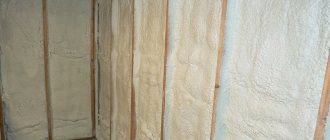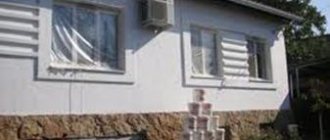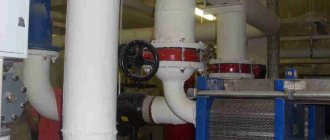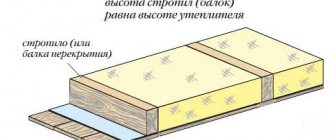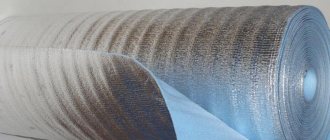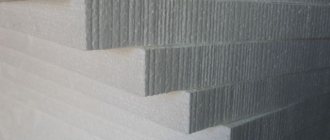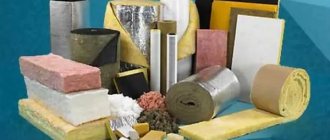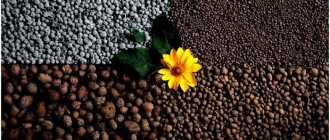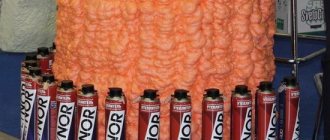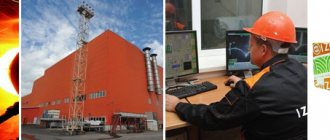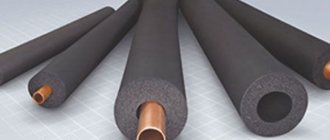What is ceramic thermal insulation
Ceramic insulation can be applied with a compressor.
Liquid ceramic thermal insulation consists of two main components - ceramic vacuum spheres and a connecting polymer composition (mastic). In appearance and consistency it resembles thick paint. The initial color of the composition is white, but you can add a variety of colors. The size of the ceramic granules is very small, so much so that they are visually invisible.
It was invented as part of the space shuttle insulation program. Then the task was to develop an effective thermal insulation material that would have minimal weight. Every additional kilogram launched into orbit is a colossal expense, so the goals are very justified. Over time, the material became available for civil engineering.
Liquid ceramic thermal insulation can be applied in several ways:
- brush;
- roller;
- spray.
In the latter case, you need to dilute the paint with plain water. This is possible since the composition is made on an acrylic base, that is, it does not contain any solvents.
The thermal conductivity coefficient differs from different manufacturers, the lowest that could be found is 0.0012 W/m*C, but thermal conductivity is rarely indicated above 0.0025 W/m*C.
This insulation is not afraid of moisture, sunlight, is not blown by the wind and can withstand extremely high temperatures. Based on the stated characteristics, the ideal insulation is liquid ceramic thermal insulation. Reviews from those who have already tried this product are somewhat different from marketing ploys. We'll talk about this a little later.
The most popular manufacturers of insulation paint:
- Astratek;
- Corundum;
- Akterm.
Features of the composition
Ceramic liquid thermal insulation is practically no different in appearance from the acrylic paint we are used to.
Today, there are several types of insulating compounds, but almost all of them have the same structure:
- The basis of liquid ceramics is a water-acrylic mixture. It ensures uniform distribution of insulating components over the surface and helps to secure the thermal insulation.
- As additional components, various additives to improve the performance characteristics of the material. The most popular additives include artificial and natural rubbers, silicone, etc.
- The main component responsible for reducing heat loss by the treated surface is ceramic granules filled with highly rarefied air. The microscopic dimensions of the granules and the almost ideal spherical shape make it possible to apply the composition very thinly to the wall.
Material structure
Note! For high-quality varieties of liquid ceramic thermal insulation, subject to complete polymerization, the proportion of voids in the insulating layer is about 75-80%. This allows you to create an ultra-thin layer on the treated surface with a very high heat transfer resistance.
Advantages and disadvantages
Compared to traditional insulation, liquid heat insulator based on ceramic microspheres has a number of advantages:
- Firstly, when insulating a house from the outside, the useful volume of the room is not lost. A thin layer of paintable insulation cannot be compared with sheathing made of mineral wool or other porous materials, so for rooms with a small area, the use of this composition can be an excellent solution.
The principle of operation of thermal paint
- Secondly, the applied layer does not degrade over time. The guaranteed service life of a ceramic coating is up to 15 years , but with proper care (application of finishing and timely cleaning), this time can be at least doubled.
- Thirdly, the mass of the material is insignificant, due to which no additional load is created on the supporting structures. This advantage of the material is especially pronounced when finishing roofs.
- Another plus is the ease of surface treatment: liquid ceramics are applied no more difficult than ordinary paint, and therefore are excellent for insulating complex architectural forms and rooms with non-linear configurations.
Photo of the treated surface
Among other things, it is worth noting the compatibility of most compositions on the market with facade and interior paints, decorative plasters, etc. At the same time, no primer is required for finishing the ceramic layer!
Note! Insulation of pipelines, outbuildings, etc. can be carried out without decorative finishing - the aesthetic appearance of the coating after polymerization allows this.
When talking about the disadvantages of ceramic insulation, they most often mention the rather high cost of the material. However, if earlier, when only foreign brands were represented on the market, this was fair, today the situation has changed somewhat. Domestic brands, such as liquid ceramic thermal insulation coating Corundum, can be purchased at quite affordable prices.
Thermal paints – ultra-thin insulation materials
Based on the application technique, liquid thermal insulation materials are divided into ultra-thin paints and foam insulation. Next we will talk about the first option, which differs from competitive products in its simplicity and speed of application .
Composition of thermal insulation material
Liquid ceramic thermal insulation is similar in appearance to thick acrylic paint. The composition of most mixtures is the same; the structure of the material is dominated by:
- Ceramic granules. The main component that helps reduce heat loss. The spherical granules are filled with rarefied air. Thanks to the minimal sizes of the components, the mixture is evenly distributed over the insulating surface . The heat insulator contains about 80% ceramic granules.
- Binding base. A water-acrylic mixture with high adhesion rates to many building materials.
- Additional components. Increases the thermal efficiency and performance of the paint. Manufacturers often use silicone, titanium dioxide, aluminosilicate microspheres, and latex additives. The components give the insulation the required water resistance and elasticity .
The effect of using thermal paint is achieved due to the large number of hollow microspheres - thermal energy losses are reduced due to normal convection. The thermal efficiency indicator of ultra-thin thermal insulation with a layer of 1.2 mm corresponds to the heat-saving ability of mineral wool of 5 cm.
Strengths of warm colors
Technical characteristics and application features allow us to talk about the following advantages of liquid thermal insulation:
- The low thermal conductivity of the material (0.001-0.0015 W/sq. m*s) provides a good heat retention effect , while the insulating layer will be minimal.
- Seamless coating. Sprayed insulation can boast of this advantage. When installing other materials, cold bridges are formed at the joints.
- Environmentally friendly. Compositions for interior work are made absolutely safe and non-toxic.
- Impossibility of dismantling. This plus is relevant when insulating country houses that are empty in winter. Attackers will not be able to remove the insulation.
- Easy to apply. The technological process is simplified as much as possible and does not require expensive equipment or experience in construction.
- Space saving. It is especially important for internal insulation of house walls.
- Resistance to moisture, counteraction to the formation of microorganisms, the appearance of fungi and mold.
- Wide operating temperature range. The coating can withstand numerous frosts and retains its physical properties at +220°C .
- Excellent adhesion. Suitable for use on metal, wood, plastic, brick, etc.
Disadvantages of liquid insulation
Skeptics question the real thermal efficiency of the innovative insulation, saying that its capabilities are exaggerated. Some experts give their arguments and point out a number of shortcomings:
- Inability to use inside the home. From an environmental point of view, there are no problems. However, after hardening, the paint creates a waterproof film on the surface - the dew point moves to the inside of the wall. Possible consequences: freezing of house structures, the appearance of fungus .
- Actual thermal insulation performance is lower than the quality declared by the manufacturers. Skeptics claim that thermal paint will replace 5 cm of mineral wool only if 10 layers are applied. However, such consumption negates the feasibility of using liquid insulation, since its cost is considerable.
- Short shelf life of the material. If the conditions are not met, then the thermal paint loses its qualities.
Useful: Types and areas of application of foil insulation
Scope of application of ceramic insulation
Where other insulation materials are powerless, ceramic thermal insulation will help.
Recently, ceramic thermal insulation has been used wherever possible, and a program for insulating facades is even supported at the state level. This insulation is suitable for:
- application to stone and concrete surfaces from the outside and inside;
- reducing heat loss from pipelines;
- protection of metal structures.
As you can see, liquid ceramic insulation is a universal product that is not applicable only to wood. The reason for this is the vapor barrier qualities of the material, and as you know, wood breathes and this process should not be disrupted.
In everyday life, this type of insulation is applied to internal walls; it can be used to cover a heating buffer tank (battery tank); even a bathtub covered with this insulation paint will retain heat longer. Also, if you use liquid ceramic insulation on the basement floor from the inside, you can solve three problems at once:
- insulation;
- waterproofing;
- vapor barrier.
In this case, the material is suitable as an auxiliary measure, since the main protection of the walls of the basement is located outside. This is a bitumen hydro-vapor barrier and extruded polystyrene foam as insulation. When ceramic insulation is used to reduce heat loss from communications or metal tanks, additional layers of thermal insulation will also not hurt.
Buying tips
The significant price of ceramic insulating compounds is the reason why you should be very careful when purchasing material in a store or on the construction market.
Instructions that allow you to avoid making mistakes and buy a high-quality heat insulator are given below:
- The first thing you should pay attention to is the density of the mixture. High-quality insulation materials are characterized by an indicator of no more than 0.6 kg per 1 liter of product. Thus, a standard ten-liter bucket should not weigh more than 7.5 kg. Otherwise, we can safely say that the thermal insulation properties of the paint will be low.
"Korund" is one of the most popular brands
- Looking at the container with the material “through the light”, you can see its delamination. Typically, the lighter fraction containing ceramic spheres ends up on top. So the thicker the top layer, the more effectively the paint mixture will retain heat.
- The third test is to determine the structure of the mixture itself. Take some paint and rub it between your fingers. Microgranules should be felt as small roughness, and their absence should be considered a reason to choose a different brand.
It is these micrograins that can be felt with your fingertips.
It is also worth paying attention to the color of the paint. The vast majority of brands of liquid ceramic insulation are produced in white, so a gray or yellowish tint is evidence of violations in the manufacturing technology. Naturally, this does not apply to compositions into which a color pigment has previously been introduced.
Surface application
Ceramic thermal paint is quite easily applied to surfaces made of a wide variety of materials.
So if you decide to do the painting insulation work yourself, you just need to follow some recommendations:
- The wall to be painted must be cleaned of dust and debris. We open up the gaps and cracks and fill them with repair compound.
- We clean concrete slabs from “cement laitance”.
- Immediately before painting, we treat the wall with a sandblasting machine, an abrasive wheel or a wire brush.
- Ferrous metal surfaces are dusted and degreased. Non-ferrous metals require preliminary removal of the gloss and application of a primer such as VL-023 or VL-02.
- Mix the ceramic composition immediately before applying it to the wall. As a rule, mixing is carried out manually.
Note! To work with large volumes, the use of construction mixers is allowed, and the rotation speed should not exceed 150-200 rpm. At a higher speed of movement of the nozzle, destruction of ceramic granules and a decrease in heat-saving characteristics is possible.
- Mixing time by hand is from 10 to 15 minutes, with a mixer - 3-8 minutes.
- Some formulations require adding water before starting work. The volume of liquid depends on the brand of material and the purpose of using the insulation. The required proportions are usually indicated on the packaging, and can also be found on the manufacturer’s website.
Applying the composition with a brush
What types of insulation are there?
Most often in stores there are two main representatives of liquid insulation: ultra-thin, which in consistency resemble paint, and foam.
The first option includes:
- Hollow aluminosilicate microspheres. They are formed from flaring coal, and the temperature must be very high;
- Latex component;
- Special dye E171, which gives a white color;
- Acrylic.
Thanks to all the components, the output is a substance that has quality parameters, for example:
- Ensuring an acceptable climate in summer and winter;
- Good reliability indicator, high resistance to deformation;
- Neutral to sunlight, therefore retains its color throughout the entire operational period;
- Does not spread when applied to the surface.
Foam insulation can be: liquid foam, which is familiar to most users, and penoizol (foamed polyethylene).
The first option shows reliability when exposed to corrosion, mice and rats. In addition to impressive thermal insulation qualities, this material can provide the owner with good sound insulation. It is used in cases where the voids formed are too large.
Foamed polyethylene, like the previous option, can be used as a void filler. For example, after installing windows, doors or during the construction of frame structures. The material has excellent reliability, strength and durability, which makes it in demand for most builders. To apply it, no thorough cleaning of the surface is required; you only need to remove traces of dirt and dust.
The main composition of such insulation includes the following components:
- Water;
- Urea-formaldehyde resins;
- Phosphoric acid;
- A special device for foam formation.
It is important to know that most of the elements present in the composition are not safe for the body. So, when carrying out work, it is important to pay attention to the choice of personal protective equipment. This way, the user will avoid getting substances into the respiratory tract and eyes.
Liquid thermal insulator TC Ceramic: specifics
Products of this brand are sold in the form of a suspension
containing acrylic polymer materials, artificial rubber and various pigments. Additionally, the composition includes ceramic microcavities and silicone spheres. The material is applied to various types of surfaces:
- brickwork;
- glass;
- plastic;
- metal;
- tree, etc.
The application method is similar to the method of treating surfaces with paint - use a roller, brush or spray.
According to the manufacturer, when treating external surfaces, the coating retains its service properties for 10 years, while when developing a layer of thermal insulation in the middle of the room, this period becomes 2.5 times longer.
The material can be used to thermally insulate both horizontal surfaces (floor, ceiling) and vertical surfaces (roof, walls, facade, etc.). The material will protect against temperature fluctuations, ultraviolet rays and moisture.
Types of insulation with liquid thermal insulation materials
Today there are 3 types of liquid insulation on sale, which are applicable for insulating walls inside and outside the room, as well as for insulating ventilation pipes, roofs, and attics.
- The first group contains ceramics. Before application, the liquid looks like acrylic white paint.
- The second group is liquid polystyrene foam or penoizol. Polymer composition applied using equipment.
- The third group is ecowool. The composition contains natural fibers. After application to the surface, ecowool has good technical characteristics.
Before applying the insulation, the surface is prepared: dust, dirt are removed, and cracks are reinforced. One of the insulation materials can get into the gap, thereby stopping the destruction. And also sealing joints.
A clean, prepared surface is the key to good adhesion to the heat insulator and a long service life.
Ceramic insulation
Liquid heat insulator based on ceramic filler is one of the most popular for insulating walls of a room and beyond. It has adhesion to brick, concrete, wood, plastic, and metal surfaces. Does not lose technical characteristics.
The heat insulator is used on plastic and drywall to increase their strength. It is safe for health and fireproof. After insulation, finishing materials are used.
Popular manufacturers
Insulation manufacturers:
- TS Ceramic. Produces insulation with the following elements:
- water base;
- synthetic rubber;
- acrylic polymers;
- additional pigments;
- empty silicone beads;
- ceramic filler.
The suspension is applied to glass, metal surfaces, and plastic. Application method: brush (like paint), roller. If the insulation remains open, it retains its properties for 10 years. Indoors, the material has a shelf life of up to 25 years. They insulate floors, walls, attics, and roofs. There is protection from moisture.
- Alfatek. It contains polymers and foam glass. Does not burn, safe for health. Temperature range -60 +260 0С. Shelf life: 20 years.
- Teplomet. Adhesion to surface. Waterproofing properties. Thermal insulation does not require coating; it can be left open. In this case, the wall looks like it is covered with paint.
- RE-THERM. Apply it to the surface, whether it is loose or smooth. Fireproof. It is applied indoors.
There are also manufacturers of this heat insulator, which has the same properties. It is applied in the same way, that is, with a roller or brush.
Advantages and disadvantages
Since insulation material has recently appeared on the market, reviews about it are different. Among the advantages are:
- does not burn;
- harmless to the body;
- ease of application;
- has adhesion to various surfaces;
- the thinness of the layer does not take away centimeters of housing;
- the weight does not put a load on the foundation;
- indicators of thermal insulation, waterproofing;
- anti-corrosion protection;
- long shelf life;
- large temperature range;
- Finish coatings are installed on the thermal insulation.
Flaws:
The downside is the high cost and lack of confidence in the new product, which has many advantages and a minimum of disadvantages.
Adviсe
- The surface must be cleaned of dust, debris and dirt. All cracks are covered with reinforcing tape and plastered.
- If the base is metal, there should be no rust on it.
- The suspension is diluted before application.
- The thickness of the applied layer is not less than 3 mm. To do this, the liquid is applied in stages. Each layer is 1 mm, with a time period of 24 hours.
- When insulating a house from the outside, siding or other finishing is required for complete insulation.
Expanded polystyrene insulation
Liquid polystyrene foam is foam (penoizol).
It hardens when opened within 2-3 hours. Because of the liquid, it fills cracks in the walls. The material does not expand like polyurethane foam, so it is used for gluing panels, replacing fasteners.
Liquid foam is sold in cylinders. If it is necessary to use it for insulation of walls and other structures, equipment is used.
Scope of application:
- Insulation of floors, attics, attic floors - horizontal planes.
- Suitable for insulating walls made of brick and concrete, as well as wooden floors.
- Filling voids between rafters, insulating inclined roof planes.
- Insulation of underground space, basements, garages.
Insulation is used in the cracks of wooden windows and other narrow spaces.
Often this heat insulator is used as glue.
Manufacturers
Penoizol is produced in certain proportions by both individuals and construction companies.
For production you need: foaming agent, ABSA acid grade A, resin, equipment. The components are easy to purchase from factories. Equipment for installing foam is expensive. One of them is “Leader 20”. All components of the insulation are mixed in it, and the material is also used to apply the material to the surface.
The equipment package includes a housing. It contains pumps, pressure gauges, and an electronic control unit.
Advantages and disadvantages
Liquid foam has advantages:
- Thermal insulation indicators. 10 cm of suspension is equal to 30 cm of ordinary foam.
- The temperature range at which the insulation does not lose its technical characteristics is -70 +200 0C.
- It is possible to use a small amount of insulation. These are small cylinders that are sold in hardware stores.
- The only insulation used to fill small voids and cracks.
- Liquid insulation is used as an adhesive and as a heat insulator. It acts as a replacement for fasteners.
- The insulation is resistant to mechanical stress, and also does not harbor rodents or insects.
- Does not rot or become moldy.
- Does not burn. Good adhesion.
- The lifespan of the installed insulation on the surface is 78 years.
- It is soundproofed.
Flaws:
- Can absorb water. To solve this problem, it is necessary to add additional elements to the composition.
- Unpleasant odor during installation.
When the foam hardens, the smell disappears.
Adviсe
To use penoizol as insulation for walls, basements, attics, and roofs, you must call a team of craftsmen. They have equipment that applies the material to the surface.
For small installation work, small cylinders are used. They work with them like polyurethane foam without any special skills.
Ecowool
The insulation consists of 80% recycled cellulose and 20% minerals, boric acid. Wood fibers, waste paper, and cardboard are used for insulation.
The material keeps the room warm. The applied composition has a smooth surface without “cold bridges”. Installation is carried out using equipment. Used for insulation of floors, places where condensation appears from high humidity.
Manufacturers
Manufacturers of ecowool:
- Greenfiber. The first place in the production of material. The use of new technologies and equipment results in the production of high quality insulation. It has thermal insulation, noise absorption, and water-repellent properties.
- Ecovilla. A manufacturer whose products are known all over the world as high-quality materials with a long shelf life and good technical performance.
- Termex. All manufactured products are environmentally friendly and have a long service life.
In addition to imported companies, there are also domestic ones:
- Ecovata Extra LLC. The heat insulator is used for insulation of residential premises and industrial buildings.
- "Equator". The cotton wool production process is automated. New European equipment is used for this. The material differs from others in its high technical performance.
Ecowool is suitable for insulating buildings due to its environmental friendliness.
Advantages and disadvantages
Positive aspects of the material:
- sound insulation indicators;
- 28-65 kg of cotton wool is needed per 1 m3. This is relatively little compared to other formulations;
- health safety;
- There are no seams or cracks during installation.
There are also disadvantages:
- installation requires equipment and a team of craftsmen;
- need a frame;
- has shrinkage;
- insulation can smolder when heated.
Adviсe
Before calling a team of craftsmen, you need to check the company for negative and positive reviews. Since many of them use low-quality compounds that can lose their characteristics in the shortest possible time.
When buying insulation yourself, you need to make sure that the packaging is intact and transparent. There should be no sand at the bottom.
RE-THERM products: what they are and how they work
To create a good layer of thermal insulation, products from the RE-THERM company are suitable. The manufacturer speaks of the material’s ability to protect surfaces of various types , also with non-traditional relief solutions. Thermal insulation
RE-THERM is fireproof, does not contain chemically hazardous substances, is considered a fully environmentally friendly material, but what is very important is that it exhibits the ability to have low thermal conductivity.
Heat insulators are available for purchase in the form of a suspension in several types to solve various types of problems:
- Standard;
- Fire retardant;
- Inhibitor;
- Ruber;
- Antifreeze;
- Vertical.
The standard is suitable for different types of surfaces; it is used for wall insulation outside and inside the house. The fire retardant was developed for rooms and structures with a risk of fire; it differs in fire resistance. The inhibitor is designated by the manufacturer as an insulating material for metal surfaces that prevents rust.
In transport, and also in systems with a risk of vibration, it is reasonable to use a heat insulator in liquid form of the Ruber brand with very high levels of flexibility. But for thermal insulation of surfaces exposed to low temperatures, thermal insulation
Antifreeze that can withstand temperatures up to? 40 degrees.
To insulate vertical surfaces while preventing material from dripping, the manufacturer has developed a specialized version of the thermal insulation with very high viscosity called Vertical.
Thermal insulation Teplomett - easy to apply and comfortable to use
Another worthy of attention insulating surface material according to today’s scheme is Teplomett products. Also, as in previous cases, the heat insulator is characterized by good thermal and moisture protection characteristics, durability, and the ability to interact with surfaces of different types
.
Thermal insulation
Teplomett is invulnerable to temperature fluctuations, damage from mechanical factors, and does not contain harmful substances.
Insulation with material does not take into account the use of an additional layer for protection due to its ability to not allow moisture to pass through. An added bonus is the multi-colored pigments included in the composition, which allow you to create a coating with a beautiful appearance. The material can be applied using one of the standard methods: brush, roller or spray.
Alfatek - liquid insulation for years
It is for many years to come that the manufacturer proposes to insulate surfaces with Alfatek liquid insulation. Just like its analogues, the material consists of many components, including foam glass and acrylic. Thermal insulation in this form is completely safe, does not contain harmful volatile compounds, is resistant to open flames, and does not lose its basic functionality at temperatures from −60 to +260 degrees Celsius.
According to the manufacturer, the service life of Alfatek liquid insulation is up to 20 years. It is used to protect communication systems, residential and industrial buildings from cold (walls, ceilings, roofs and floors are insulated), air conditioning systems, pipelines, etc.
Thermal insulation Isollat - special insulation of a new generation
The material was developed in Yekaterinburg and has occupied a strong position in the market for more than 10 years. The manufacturer recommends using thermal insulation within the temperature range from −60 to +500 degrees Celsius, with the possibility of increasing the extreme mark to +600 degrees in critical situations. It is precisely this wide range of temperatures permissible for operation that distinguishes the insulation from its analogues.
The color of thermal insulation in the basic version is white; at the buyer’s request, color pigments of any shade can be added to the composition.
The composition includes hollow ceramic capsules with rarefied air, due to which it is possible to take the effectiveness of the material to a new level.
Thermal insulation is available in six options:
- Izollat-01 is suitable for insulating walls and roofs, both inside and outside, including in buildings with many years of service.
- Isollat-02 is the base material for insulating surfaces for use in temperatures ranging from −60 to +170 degrees.
- Isollat-03 - contains fire retardant additives that prevent ignition.
- Isollat-04 is the only one in the whole world capable of withstanding temperatures up to +500 degrees and up to +600 degrees at critical moments. Suitable as insulation for industrial equipment.
- Isollat-05 - suitable for insulating metal surfaces susceptible to corrosion. Can be used at temperatures up to +160 degrees with additional treatment with silicone varnish.
- Isollat-nano - used for insulation of external walls, has the ability to self-clean.
The latter option is rarely available on store shelves, as it is offered to the buyer on order.
Liquid insulation Corundum - performance characteristics
The production of ultra-thin insulation Corundum is carried out by NPO Fulleren LLC. In the domestic market, products under this brand are in particular demand, primarily due to the proliferation of dealership centers.
Thermal insulation suspension is suitable for insulating facades, roofs, walls, pipelines, tanks and other objects, systems and structures. The material is available in several versions:
- Classic - for finishing surfaces of any type with intended use in the temperature range from −60 to +200 degrees Celsius (a critical increase in temperature up to +260 degrees is possible).
- Anticorrosive - just like its analogues, it is used to insulate and protect surfaces from corrosion, and exhibits increased resistance to UV rays and chemicals.
- Winter - coating for finishing surfaces at sub-zero temperatures down to −20 degrees. The composition includes foam glass granules. Samples available for testing.
- Facade - insulation for finishing concrete external surfaces.
The cost of the material depends on the brand and purpose; the material is applied in the usual way: with a roller, brush or spray.
Which company is better for choosing liquid insulation?
There are dozens of manufacturers on the market that guarantee reliability and durability. However, according to buyers, good examples are:
- AKTERM - the company has been producing liquid thermal insulation for 6 years. During its existence, the company has gained a reputation as a leader among manufacturers of universal insulating materials in the domestic market and the market of the CIS countries.
- Astratek. The company produces only safe and environmentally friendly thermal paint, enjoys the trust of people, and the service life of materials from this company is 30 years. Possibility of traces of mold, mildew, etc. excluded.
- Corundum. A representative from a more expensive segment, which has high strength parameters. Due to its high-quality adhesion, it can be applied to almost any surface.
- Thermometa. Withstands negative temperatures down to -60 degrees, which allows you to use the device in almost any area. There are also certificates confirming the environmental friendliness of the materials used.
- Armor. Substances from this manufacturer have high adhesion not only to concrete and brick, but also to metal and wood. The product is often used for thermal insulation of pipelines.
- Green Planet. Models from this company are widely used for insulating houses, apartments and frame houses.
Akterm - operating principle and line of ultra-thin thermal insulation
The products are manufactured at a plant in the Moscow region and are positioned by the manufacturer as a material that can withstand operation in temperatures ranging from −60 to +250 degrees, and in the case of using a special brand - up to +600 degrees. The line of insulation includes the following modifications:
- Standard - for insulating base surfaces, including those made of concrete and metal, when operating in conditions from −60 to +260 degrees.
- Facade is a specially developed insulation material for thermal insulation of external walls made of concrete and wood.
- Nord - the versatility of the insulation lies in the possibility of application on surfaces at sub-zero temperatures down to −30 degrees.
- Anticorrosive is a special heat insulator for surfaces at risk of rust.
- Non-flammable - suitable for installing an ultra-thin heat-insulating layer that is resistant to fire.
- Anti-condensation - designed for insulation of surfaces with an increased level of condensation.
- Vulcan is a material for thermal insulation of objects whose operating temperature exceeds the norm and is equal to +600 degrees Celsius.
The listed brands of insulation in the form of a suspension are most widely used on the Russian market. In addition to them, European-made materials are also available, the cost of which is higher due to transport costs and brand name, but not due to any special performance characteristics.
Liquid thermal insulation: advantages
Does not create loads on load-bearing structures of buildings. Environmentally safe. Does not contain harmful substances. It has good resistance to both alkalis and acids. Does not support combustion.
The best liquid thermal insulation
AKTERM Concrete™
This is ultra-thin liquid thermal insulation based on water dispersion. Suitable for:
- insulation of basements, loggias and balconies;
- insulation of facades and seams between panels;
- insulation of “breathing” concrete, brick and lime surfaces;
- protection of floors and walls from freezing;
- internal wall insulation;
- insulation and insulation of slopes on windows.
Used instead of foil in underfloor heating systems.
The consumption of liquid thermal insulation is 1 l/1 m2, if applied in a layer of 1 mm. By the way, overspending is allowed if the surface is too porous. Before using AKTERM Concrete™, experts advise first applying an acrylic primer to the surface. The color after complete drying is white.
The coating dries at room temperature for 24 hours. After this, decorative plaster is applied, wallpaper is glued, or the surface is painted with water-based decorative paint. When the heat-insulating layer dries, the coating will withstand temperatures from -60 to +150 degrees Celsius.
AKTERM Concrete™ is applied in a millimeter layer at above-zero temperatures of 7-45 degrees Celsius. If the surface area that you plan to treat is small, then experts recommend using a brush or spatula to apply liquid thermal insulation.
To treat large rooms, experts advise applying liquid thermal insulation using airless spray units. AKTERM Concrete™ is produced in plastic buckets with a volume of 2,5,10 and 20 liters.
The average cost for 10 liters is 3,550 rubles.
AKTERM Concrete™
Advantages:
- the material does not flake, even if stored for a long time;
- liquid insulation is immediately ready for use (there is no need to mix the material with anything else);
- dries in half an hour until touch-free;
- in small rooms it is applied with a roller, spatula or brush;
- there are no organic substances or volatile components in the composition - the material is fireproof and non-toxic.
Flaws:
- not detected.
Armor Station Wagon
Liquid ceramic thermal insulation "Bronya Universal" is suitable for insulating metal, wood, concrete, and plastic coatings. This product has found wide application in the insulation of various pipelines. It is used for thermal insulation of water supplies, heat pipelines, ventilation ducts, furnaces, various containers or cisterns. It is also applied to prevent the formation of condensation.
The recommended application layer is 0.5 mm, drying between each layer should be at least 24 hours. The product is applied using a brush, a special spray bottle or a spatula. If you apply Bronya Universal with a thickness of 1 mm, then the consumption is 1 liter per 1 sq.m. You should also take into account possible cost overruns, which can be up to 30%. This parameter depends on the application method and skill level.
Work with this heat-insulating material should be carried out at a temperature not lower than +5 degrees. If work is carried out indoors, then the temperature there should be +7-+120 degrees. If “Bronya Universal” is applied to a surface whose temperature is above +60 degrees, then the product must be diluted with water in a ratio of 1 to 1. After the thermal insulation has completely dried, the room can be operated in a temperature range of -60-+120 degrees.
This heat-insulating agent can be purchased in plastic buckets of 5, 10 and 20 liters. It is also produced in two versions: low-flammable and non-flammable.
The average cost of a low-flammable option for 5 liters is 1,500 rubles, and a non-flammable option is 1,600 rubles.
Armor Station Wagon
Advantages:
- Suitable for all surfaces;
- A small percentage of overspending;
- Convenient application;
- It is produced in two groups according to the degree of flammability.
Flaws:
- Not suitable for use at temperatures above 140 degrees.
Armor Nord
A distinctive feature of this liquid insulation is the possibility of application at negative air temperatures. The minimum permissible application temperature is 35 degrees. "Bronya Nord" is suitable for insulating any surfaces, including plastic, wood, brick and metal.
The manufacturer recommends applying Armor Nord using a brush, roller or spray. The applied layer should be no more than 1 mm, drying between layers should be at least 24 hours. The consumption for this application will be 1 liter per 1 sq.m. Before starting work, this thermal paint should be brought into working condition using a solvent.
After the thermal insulation has completely dried, the product can be used. We allow temperature conditions from -60 to +70 degrees. If the product is planned to be used at higher temperatures, then you should choose the “Armor Winter” thermal paint. After polymerization, this insulation can be used in temperature conditions from -60 to +90.
"Bronya Nord" is packaged in metal buckets of 10 and 20 liters. Also, this modification of thermal insulation has two degrees of flammability: low-flammable and non-flammable.
The average cost of a low-flammable option with a volume of 10 liters is 3,900 rubles, and a non-flammable option is 4,200 rubles.
Armor Nord
Advantages:
- A budget option for warm paint that can be applied at sub-zero temperatures;
- Has two degrees of flammability;
- Can be applied using any tool;
- Slight overconsumption when applied to large surfaces.
Flaws:
- A product coated with Bronya Nord cannot be used at temperatures above +70 degrees;
- Not available in small quantities.
Green Planet Thermoshield Standard
Liquid thermal insulation "Thermoshield" is used to quickly solve insulation problems. "Thermoshield" can be used on any surface that does not "breathe". For example, glass, plastic, metal, etc. This product will help cope not only with thermal insulation, but will also help in the fight against rust, mildew or mold.
Termoshield is mainly used for insulation of pipelines, metal structures, roofs, tanks, as well as for thermal insulation of plastic window frames and refrigeration units.
The consumption of Termoshield thermal insulation is 1 liter per 1 sq.m., when applying a layer of 1 mm. This product can withstand 10 cycles of frost resistance. After complete drying, they will retain their properties at temperatures from +5 to +150 degrees.
The average cost of a 1 liter bucket is 380 rubles.
Green Planet Thermoshield Standard
Advantages:
- Suitable for application to any surface;
- Does not collapse under environmental influences;
- Non-toxic;
- Not flammable.
Flaws:
- The maximum packaging volume is 10 liters.
Magniterm Standard
This insulation of the Magniterm brand is suitable for working with any surface. It is usually used for thermal insulation of pipes, roofs, walls, and various containers. After complete drying, the surface acquires a matte tint. The materials used in the manufacture of Magniterm Standard are manufactured in France and Sweden. It is also worth noting that, unlike other models of insulation, it is not water-based, but silicone.
The ambient temperature when applying Magniterm Standard should be no lower than +5 degrees. After complete polymerization, the product can be used at temperatures from -60 to +200 degrees. The average consumption when applying a layer 1 mm thick is 0.8 l/sq.m. Packing is done in plastic buckets with a volume of 10 liters.
The average cost is 3300 rubles.
Magniterm Standard
Advantages:
- Silicone base;
- Consumption is less in comparison with analogues;
- It will help reduce costs during the heating season by 40%.
Flaws:
- Packaged in 10 liter buckets only.
Teploplus
Liquid thermal insulation consists of an aqueous acrylic base with the addition of a ceramic filler. "TeploPlus" is suitable for both internal and external insulation work. This product is used for insulating products or structures made of metal, brick, concrete, wood.
A layer 1 mm thick. corresponds to mineral wool 50 mm thick. After the finishing layer has completely dried, the product can be used in temperatures ranging from -60 to +260 degrees. The layer formed by TeploPlus thermal insulation will create a thermal barrier and also reflect heat, thereby maintaining the set temperature. When applied to pipes, condensation will be prevented and protection against freezing will be provided. Also, the substances included in TeploPlus will protect the surface from the appearance of mold or mildew.
"TeploPlus" is completely safe for the environment, non-toxic and odorless.
The average cost of TeploPlus with a volume of 10 liters is 3,000 rubles.
Teploplus liquid thermal insulation
Advantages:
- After coating, the product can be used in a wide temperature range;
- Odorless;
- Environmentally friendly product;
- Suitable for application on any coating.
Flaws:
- No.
